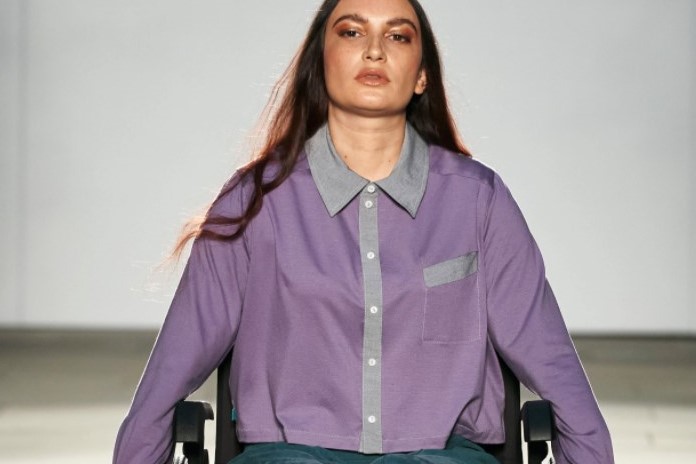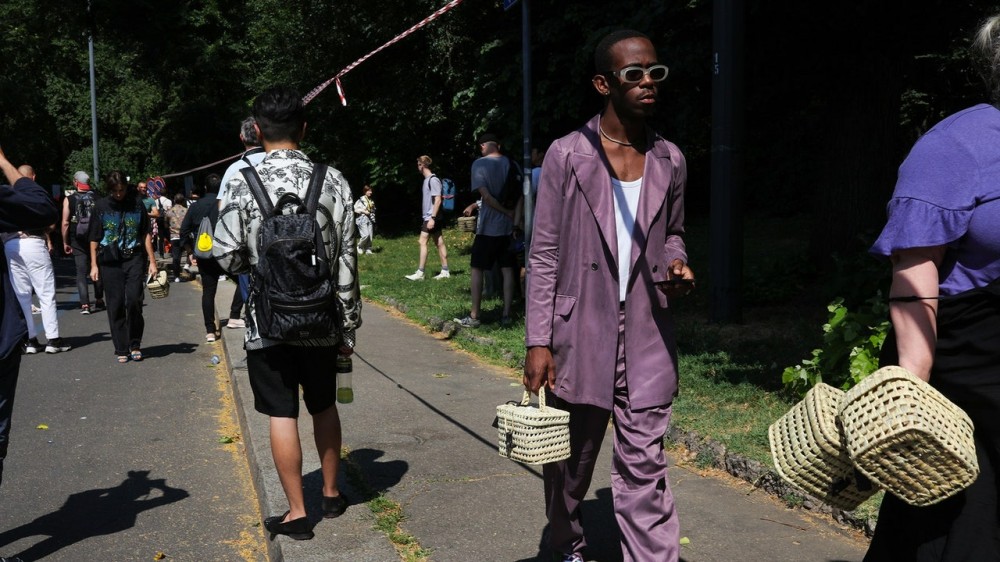
Harriet Eccleston is the adaptive fashion designer making her mark at LFW
Combatting the fashion industry’s exclusion of 14.1 million disabled people, the winner of the Faduma’s Fellowship design competition made her runway debut for SS22
While fashion sometimes moves too swiftly a pace to even keep track of, the process of diversifying its catwalks is happening at a glacial pace. Yes, we are finally seeing a broader range of shapes, sizes, colours, and genders grab the spotlight they deserve, meaning it would be easy to assume that adaptive fashion was having an equally heart-warming surge. In reality, the fashion-starved disabled community continues to be be passed over again and again. However, to combat the style exclusion of 14.1 million disabled people in the UK and the one billion disabled folks worldwide, a colourfully dressed, fashion powerhouse is embarking on a mission to affect change.
Faduma Farah, who became a wheelchair user after a near-fatal case of meningitis in 2011 confronted the fashion industry’s neglect with the launch of a £10,000 design competition – Faduma’s Fellowship – to create a wheelchair-friendly collection. While other specially designed clothing is well-established, like maternity lines, which cater to less than one millon pregnant people per year, most adaptive fashion is still stuck in hospital chic mode. In the luxury sphere, Tommy Hilfiger is leading the charge with adaptive lines – but still, cool clothes for those with different abilities remain rare.
Sifting through the incredible design submissions, the competition brought together a panel of judges: Tiffany Saunders, runway and campaigns director at Oxford Fashion Studio, fashion analyst Anusha Couttigane, disabled stylist and influencer Heidi Herkes, and stylist and writer Virginia Chadwyck-Healey. This group then shortlisted six entrants: Ellen Fowles, Rizwana Matadar, Harriet Eccleston, Chamiah Dewey, Alina Green, and design duo Emma McCelland and Alison Black.
It was womenswear designer Harriet Eccleston who was ultimately crowned winner, though. Having worked with research twins Rebecca and Mel Everett, Eccleston is now collaborating with Farah to create a collection with disabled peoples’ needs at its heart. Launching this London Fashion Week, the final designs will cater to a wide range of disabilities, including the 1.2 million wheelchair users in the UK, and will hopefully encourage more designers to rethink their approach to adaptive fashion, which has historically been bland at best, and impractical at worst.
With a combined annual spending power of £249 billion, it is clear that the disabled community in the UK is ready and willing to shop – and this upcoming collection aims to please. Here, we speak with the winner about her approach to designing adaptive clothing, infusing her design aesthetic with the project’s demands, and what lessons she’ll be taking forward. Plus, meet the finalists in the gallery below.

What inspired you to apply for the fellowship?
Harriet Eccleston: To be honest, I wasn’t going to apply, which sounds awful now. I just thought, I don’t know anything about adaptive clothing, but the more I thought about that fact, the more shocked I was. I’ve gone through four years of uni, Art Foundation, textiles classes prior to that, and I’ve gone through years in the industry, and nobody had ever stopped and said, ‘hang on, there’s 20 per cent of the population that can’t wear the clothing we’re discussing’. The more I thought about it, I was shocked and staggered, and then I thought, this is something I need to do.
How did you approach researching adaptive clothing?
Harriet Eccleston: I remembered I had a friend from uni and she’d gone on with her twin sister to do a Master’s and their thesis was about the lack of adaptive clothing available. Rebecca and Melissa Everett gathered data and research from a variety of people with varying abilities such as wheelchair users and those with manual dexterity loss, as well as medical researchers. This enabled them to analyse disability in the fashion industry and identify areas to consider when designing adaptive clothing. Their knowledge and first-hand research has been invaluable in helping me better understand the issues that many people face and develop design solutions.
Why is adaptive fashion behind other inclusive fashion?
Harriet Eccleston: I don’t understand why the conversation is not happening. I’ve come across some brands that design adaptive clothing without having design at the heart of what they’re doing. There’s been a lot more conversation about different sizes, different races, different ages within the fashion industry, and adaptive clothing has just been completely left behind and not talked about. I think what’s also interesting is some adaptive clothing is often designed with the older generation in mind, but also more for the carer to dress the person so fastenings are on the back, it doesn’t actually make it easier for the person that’s wearing it.
“There’s been a lot more conversation about different sizes, different races, different ages within the fashion industry, and adaptive clothing has just been completely left behind and not talked about” – Hannah Eccleston
How did you infuse your personal design aesthetic with this project’s demands?
Harriet Eccleston: It was quite difficult actually, because a lot of my work is quite oversized. But it’s the idea of these timeless pieces that are also seasonal, so they just slip right into anybody’s wardrobe very easily. We’re trying to create a collection that hopefully is a real pleasure to wear and represents the person who’s wearing it. My work is very simply more monochrome with sort of hints of playful colour and I had a lovely meeting with Faduma, and she showed me her wardrobe. It’s very different from mine and is absolutely bursting with incredible colours and patterns, so it’s been really interesting to hear her thoughts and try and interlace the two.
What was the biggest learning curve during the process?
Harriet Eccleston: I’m very technically minded so it was really interesting and I really thrived off of that. It was a real challenge to work out how technically things could be put on easily or fastened easily, or just pocket positions and things like that. The biggest learning curve was really just to stop, consider and to understand (their needs).

How has the experience changed your design approach?
Harriet Eccleston: I believed that I was running a responsible and sustainable brand because everything’s individually crafted, next to no waste, and locally crafted, and I have a lovely relationship with my customers. But obviously, now I know that I wasn’t quite doing enough. I want to try and do as much as I can to ensure that the pieces I produce are available to as many people as possible.
How do you feel about the win?
Harriet Eccleston: I feel really humbled to be trusted by Faduma because this is her vision and the team have worked so hard to bring it to this point. I’m just delighted to be actually working on it and to see the pieces come to life now is really exciting. I just can’t wait to see them on the catwalk. The idea is that it’s for literally everybody to have, all abilities! Hopefully it appeals to literally every single person.
What’s next for you after the fellowship?
Harriet Eccleston: To keep doing what I’m doing and to integrate a bit more of the thinking that’s come through Faduma’s Fellowship. I just really hope that we can get more people talking about this, you know, in universities, talking to students and making them aware of designing adaptive clothing because it’s shocking that it’s not happening more. I just really hope that moving forward I can be a part of that and spread the word.



